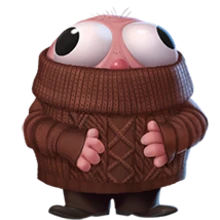2 Techniques Disney uses to Creatively Convey the Complex to Children
- adriannawaters4066
- Sep 28, 2020
- 6 min read
Updated: Oct 19, 2020
From magic potions to fantastical creatures, Disney movies are no stranger to conveying the impossible; however, Disney movies also take complex topics based in reality and use creativity and imagination to bring the information to children's level of understanding and cognitive skills.
Children's storytelling relies on different strategies to write for children, but I have noticed two effective and common storytelling techniques that Disney uses in their films: creating characters based on complex ideas or creating concrete, imaginative, and creative scenarios to explain abstract ideas.
While several movies employ one or both of these techniques, there are two movies that I find especially effective: Inside Out and Ralph Breaks the Internet. It's also interesting that these are two of Disney's recent movies, showing that the movies are developing more complex plots.
Inside Out: Bright Colors and Concrete Imagery to Explain Psychology, the Brain, and Emotions
With the five main characters being emotions, Inside Out uses characters with needs, wants, and personalities to explain to children the importance of sadness and the complex interplay between emotions. Telling children that memories can be both joyful and sad won't quite compute. The main audience of Inside Out is anywhere from 5-11 years old, meaning they are either in the preoperational stage or concrete operational stage of Piaget's Stages of Cognitive Development. This means they don't have the Formal Operational Stage's ability to think about abstract topics, which starts to develop in adolescence. Instead, Inside Out takes two abstract ideas (happiness and sadness) and uses Joy and Sadness as characters to show how Riley can be both happy and sad about her ice skating memory.
Inside Out also uses characters to explain some of the complex features of the brain. For example, the Mind Workers play a very small and specific role: they show how memories fade and disappear by vacuuming them up, and they show how memories resurface by sending the Triple Dent gum commercial song up to headquarters. In fact, the Mind Workers effectively explain memory by using the second technique as well.
The concept of memory is fuzzy even for adults to understand; children, who are constantly taking in new information, applying the new concepts to their preexisting schemas, and sorting through their memories, don't have the cognitive capacity to fully understand how memories work or why they forget some information. To explain the abstract concept of memory, Inside Out uses concrete images or actions, such as black and white imagery or the dropoff cliff:
Inside Out uses imagery that children understand to explain memory, specifically using memories that most children have or can relate to: piano songs, U.S. presidents, names of toys, etc.
In the above video, the faded memories are in black and white, contrasting to the bright colors of the necessary memories. Children, who are attracted to bright colors, understand this: bright colors = good and fun; no colors= not fun. They can then understand that the orbs which are black and white are "not good" in some way.
The metaphor is furthered when the Mind Workers suck up the faded memories to show that they are "going away;" finally, the memories fall into the Memory Dump, which has faded and dark colors. Children are familiar with these simple images (black and white orbs, vacuum, cliff), so they can apply their experiences with them (black and white= not good, vacuum=suck up, cliff= away) to understand that Riley's old memories are not useful anymore and went away.
Memory isn't the only complex psychology topic Inside Out covers. Riley's personality islands use amusement park imagery to convey her main traits:
Riley's personality islands use bright colors and amusement park imagery, like Ferris Wheels or fireworks, to convey her different character traits.
From left to right, images retrieved from Pinterest, Oh My Disney, and Psychology Today.
Imagination Land shows Riley and other children's capacity to imagine, and as Riley gets older, her imagination and fantasies change.
Imagination Land shows the concept of "imaginative play," which children are actively engaging in, and demonstrates how imagination changes throughout the years.
And of course, to add a little humor in for the adults, Inside Out uses the memory train and a box of tiles to show how facts and opinions seem to be interchangeable sometimes:
This is a great example of a way that Disney caters their movies to adults as well. The memory train and boxes of facts and opinions are concrete images for children, but the joke is geared toward adults.
The brain is a complex subject that even adults struggle to grasp, but Inside Out's use of colorful characters and concrete images bring the subject area down to the cognitive capabilities of children. On the other hand, Ralph Breaks the Internet tackles a more modern topic, one that children are experiencing much more frequently.
Ralph Breaks the Internet: Prototypical and Familiar Images to Explain Wifi and the Internet
WiFi and the internet are complex subjects even for adults, and with children becoming even more engrained in digital media, the internet is especially relevant. Like Inside Out, Ralph Breaks the Internet uses characters to explain subtopics under the internet.
For example, Spamley, Gord, and Double Dan represent pop-up ads and viruses, and Ralph Breaks the Internet attaches imagery or traits to the characters that children will understand. Spamley, who represents pop-up blockers, takes on traits that match up with the annoyance of pop-up blockers. He is a sickly shade of green, a color that children recognize is associated with undesirability. Spamley also fidgets, and this shows the sketchiness of pop-up blockers.

Spamley's green skin tone is the first clue that his character represents something shady.
Photo retrieved from Disney Fandom | Spamley.
Likewise, Gord and Double Dan explain viruses and the Black Market on the internet, two topics that children may vaguely know about without having a complete understanding of what they do. Gord's imagery shows his sketchiness; he has huge eyes and a sweater pulled all the way up his face, obscuring his nose and mouth—if he even has a mouth. Gord's actions match this; he never speaks and suddenly pops us when called. Double Dan, who gives Ralph the virus, is a giant, yellow-green slug with what looks like a mole with a face; his imagery provides no doubt to children that Double Dan, and everything associated with him, is not good.
With Gord's large eyes and Double Dan's slug-like appearance, children form automatic assumptions that the characters are not meant to represent heroic actions.
Photos retrieved from Disney Fandom | Gord and Disney Fandom | Double Dan.
Additionally, Knowsmore represents search engines. To show that Knowsmore—and thus search engines—have an infinite amount of knowledge, the creators give his character intelligent imagery that children can recognize, such as glasses, a book, and a graduation cap. Yesss represents even more complex ideas, algorithms and internet fame, topics that even adults don't fully understand. Her fashionable and hip clothing gives off the idea that she is "in the know," and her very name "Yesss" suggests that she can do anything.
Ralph Breaks the Internet uses prototypes, such as glasses and a graduation cap or a fur coat, to attach character traits to Knowsmore and Yesss.
Photos retrieved from Disney Fandom | Knowsmore and Disney Fandom | Yesss.
Ralph Breaks the Internet relies mostly on characters to convey the complexity of the internet, but the movie also uses concrete images or scenarios. To show people using the internet, mini avatars walk around the physical space of the internet, providing concrete imagery for a topic that is otherwise only conveyed with code or screens. Because avatars are used in several gaming platforms, children can reasonably see the simplified images of people and understand that they represent actual people.
One of the first locations these avatars visit is Knowsmore's kiosk. Knowsmore's character demonstrates the vast knowledge of search engines, but after internet users visit Knowsmore, they are transported to their desired site by riding in a vehicle until they reach what looks like a technology island representing a website, imagery that children are familiar with.
In this video clip, we see Ralph taking on the same thought processes that children experience. Ralph needs help, he sees Knowsmore, and he recognizes Knowsmore can help because "he's got one of those hats that smart people wear."
Do you enjoy how Disney's recent films are venturing out into more complex topics? Are there other films that you notice use characters and concrete scenes to explain difficult topics? Feel free to send me a message or post a comment below!
Until later, have courage and be kind.

















Comments